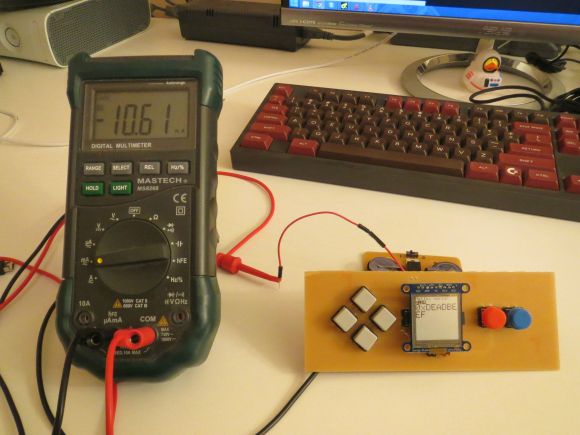
These days, it’s easy enough to play games on the go. If you have a smart phone, you are pretty much set. That doesn’t mean you can’t still have fun designing and building your own portable gaming system, though.
[randrews] did just that. He started out by purchasing a small memory LCD display from Adafruit. The screen he chose is low power as far as screens go, so it would be a good fit for this project. After testing the screen with a quick demo program, it was time to start designing the circuit board.
[randrews] used Eagle to design the circuit. He hand routed all of the traces to avoid any weird issues that the auto router can sometimes cause. He made an efficient use of the space on the board by mounting the screen over top of the ATMega chip and the other supporting components. The screen is designed to plug in and out of the socket, this way it can be removed to get to the chip. [randrews] needs to be able to reach the chip in order to reprogram it for different games.
Once the board design was finished, [randrews] used his Shapeoko CNC mill to cut it out of a copper clad board. He warns that you need to be careful doing this, since breathing fiberglass dust is detrimental to living a long and healthy life. Once the board was milled out, [randrews] used a small Dremel drill press to drill all of the holes.
The final piece of the puzzle was to figure out the power situation. [randrews] designed a second smaller PCB for this. The power board holds two 3V coin cell batteries. The Arduino expects 5V, so [randrews] had to use a voltage regulator. This power board also contains the power switch for the whole system.
The power board was milled and populated. Then it was time to do some measurements. [randrews] measured the current draw and calculates that he should be able to get around 15 hours of play time using the two 3V coin cell batteries. Not bad considering the size.
[via Reddit]














I’m curious what he used for a voltage regulator. Most 7805s and similar chips have a voltage drop between 1.25v and 2v. Theoretically, 6v should be insufficient voltage to do the job.
That’ll chew through the CR2032s – they have a rather high internal resistance and sustained current draw over a few ma kills them pretty quickly.
http://www.ti.com/lit/wp/swra349/swra349.pdf
I’d suggest a quad AAA pack with NiMh rechargeables, without a regulator. It should start off around 5.4v, and go down to about 4.5 at 90% discharged.
And you can always drop a few tenths of a volt just by using a diode. Different ones (eg Schottky) have different voltage drops. You can of course use several in series.
Always good to see Aduino-based game devices. That display is a bit pricey though, the same money could have bought a ready-made Gamebuino (http://gamebuino.com/).
Nice keyboard
… and nice XBox and nice backwards wiring on the meter!
yes…with a Commodore key :-) Let us know what kind of keyboard it is !
What kind of keyboard is that?
Looks like a commodore symbol to the right of the space bar.
I can’t place it, but I bet Bill Herd can.
+1 on that question
–> as soon as I saw the image I figured I wouldn’t be the only one wondering… :)
its probably a painted cm qfr. The keycaps are definitely the DSA retro set from geekhack
You can get a better picture (taken with an iPhone) at http://i.imgur.com/Jq1kwXs.jpg
It’s a KMAC –>http://www.originativeco.com
Same here what kinda keyboard is that…
I thought that before i even knew what the post was about…
ME WANT KEYBOARD >>>>
(Zombies around) KEEEEYYYYYYSSSSS
The keyboard is a mechanical based on Cherry MX switches, it could be a Ducky, Filco, Leopold, or something else that has a minimalist matte black shell. What everyone is really asking about is the keycaps. Going entirely by memory, that’s a custom made keycap set that was a group buy on geekhack (unless it was deskthority) at least a year ago, and is no longer available. Sets of keycaps like that tend to cost $60-100 each due to the special order nature and the low number produced, and that’s in addition to a $100+ keyboard.
It may look a huge amount of money for a keyboard, but as a proud Model M IBM owner since decades I’m pretty sure all these keyboards are going to outlive their owners.